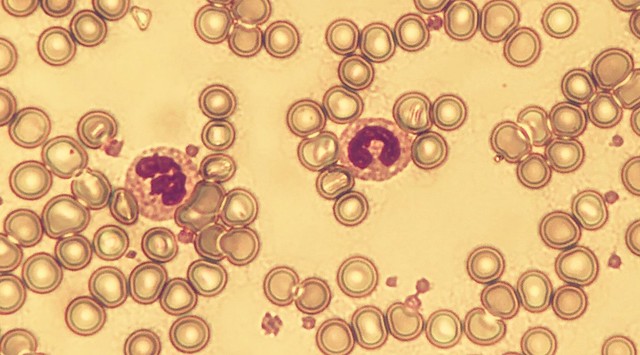What is SDS?
Shwachman-Diamond Syndrome (SDS), first described in 1964 by the British ophthalmologist M. Bodian (Bodian et al.; 1964) and the US physician H. Shwachman and pediatrician L. Diamond (Shwachman et al.; 1964), is a rare inherited/congenital disease that is classically associated with an exocrine pancreatic insufficiency, a bone marrow failure and in an impaired growth (skeletal malformation). Beneath that SDS can also affect other organs e.g, the skin, liver, heart, immune system and the central nervous system.
Genetics
The Shwachman-Diamond syndrome is primarily caused by a mutation in a single gene, the Shwachman-Bodian-Diamond protein SBDS (Boocock et al.; 2003). In approximately 90-95% of SDS cases a mutation of this SBDS gene on Chromosome 7 can be detected. The mutation is inherited in an autosomal recessive pattern meaning that each parent is a healthy carrier of the disease. Parents who are carriers of a SBDS mutation have a risk of 25% to have a child with SDS, a 50% chance that their child is being a carrier of the mutation (without having the disease) and a 25% chance that the child is unaffected. Reports show that a mutation in the SBDS gene can also be acquired spontaneously (Steele et al., 2014). However 5-10% of SDS patients do not show a mutation in the SBS gene. Recently, another three genes have been associated with an SDS-like phenotype DnaJ heat shock protein family member C21; DNAJC21 (Tummala et al. 2016), elongation factor-like 1; EFL1 (Dhanraj et al. 2017) and signal recognition particle 54; SRP54 (Carapito et al.; 2017). All four genes have in common that they are involved in the biogenesis of ribosomes, proteins that are involved in the protein production of the cell why SDS can be also characterized as a ribosomopathy (Warren A.; 2018).
Hematological manifestations
 Flickr Neutropenia is the most common manifestation of bone marrow failure in SDS patients leading to a higher susceptibility to viral, bacterial and fungal infections. During early infancy these infections can lead to life-threatening situations.
Flickr Neutropenia is the most common manifestation of bone marrow failure in SDS patients leading to a higher susceptibility to viral, bacterial and fungal infections. During early infancy these infections can lead to life-threatening situations.
Neutropenia is a condition, in which the number of blood neutrophilic granulocytes (neutrophils), a subgroup of the white blood cells or leukocytes, responsible for the immune defense against bacteria, viruses and fungi, is diminished. The level of neutropenia may vary considerably. In general, the blood of healthy adults contains about 1500 to 7000 neutrophils per mm3 (1.5 – 7.0 x 109/l). In children under 6 years of age, the neutrophil count may be lower. The severity of neutropenia generally depends on the absolute neutrophil count and is described as follows:
- mild neutropenia: when the ANC falls below a lower limit of 1500 per mm3 (1.5 x 109/l), but remains higher than 1000 per mm3 (1.0 x 109/l)
- moderate neutropenia: when the ANC falls between 500 per mm3 and 1000 per mm3 (0.5 x 109/l - 1.0 x 109/l)
- severe neutropenia: when the ANC falls below 500 per mm3 (0.5 x 109/l)
The duration of the neutropenia may be short-lived. In short-lived cases, the patient is described as suffering from acute neutropenia. "SCN" stands for "severe chronic neutropenia", summarizing a group of conditions, in which neutropenia persists for more than three months.
Some SDS patients suffer also from anemia or show a higher bleeding tendency due to a reduction in other blood cells such as erythrocytes and thrombocytes. Anemia is characterized by clinical symptoms such as headaches, fatigue and paleness.
Pancreatic dysfunction
In addition to the bone marrow failure SDS patients show a defect in exocrine pancreatic function making it difficult to digest different food components as the secretion of proteolytic enzymes is severely decreased. Therefore, the intestine is not able to absorb all of the fat and nutrients from food which can lead to malnutrition and vitamin deficiencies (vitamin A, D, K). Patients with SDS exhibit steatorrhea (fatty, foul-smelling stools) and may also show a growth deficiency/failure due to missing uptake of nutrients in the first year of life, especially prior to diagnosis.
Other manifestations
Skeletal abnormalities / skeletal dysplasia are also frequently seen in patients with SDS as many individuals show problems with bone formation (low turnover osteoporosis). These include the growth impairment of hip and leg bones, rib cage abnormalities (thoracic dystrophy) and shortened ribs with flared ends (costochondral thickening). These abnormalities are among the most variable components of SDS. The skeletal abnormalities and the slow growth can lead to a short stature in patients with SDS.
In addition, hepatomegaly is often seen in children with SDS having elevated serum liver enzymes that tend to resolve with age. Beneath this SDS patients may also show a delayed dentition of permanent teeth, abnormalities of the kidney, eyes, skin, heart or nervous system.
Risk of MDS/Leukemia development
Patients with SDS have a higher risk to develop malignant diseases such as myelodysplastic syndrome (MDS) or leukemia, particularly AML (acute myeloid leukemia). The reason for this is currently not known but is subject of the present clinical research, also supported by the SDSR-EU.